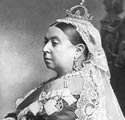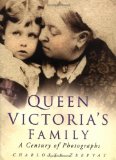Short Biography of Queen Victoria (1819 –1901)
Queen Victoria was born 24 May 1819. Aged 18 she became Queen of Great Britain and she went on to rule for 63 years – at the time – she was the longest-serving Monarch in Europe. She ruled through a period of British imperialism with the British Empire expanding and she became Empress of India. She came to epitomise an era of social conservatism and economic expansion.
She was the granddaughter of George III, and her father, Edward was fourth in line to the throne. However, her father’s three brothers all died without leaving any living relatives. She was crowned Queen on 20 June 1837 and ruled until her death 63 years later in 1901.

Early life
Her early life until the age of 18 was closeted and carefully controlled by her mother and her assistant John Conroy. Her mother,
Princess Victoria of Saxe-Coburg-Saalfeld kept Victoria very close and allowed her little real-life experience. She was brought up with a strict set of rules and regulations known as the ‘Kensington System’. Victoria described her childhood as “rather melancholy.” In 1830 her grandfather George III died. He was succeeded by King William IV, but in 1837, he also passed away, meaning the crown passed onto Victoria who was aged only 18, and somewhat unprepared for the role.
One of her first decisions was to cut free from her mother and gain more independence from the controlling atmosphere she had been brought up in. She also took her new duties very seriously. On her ascendency to the throne, she said:
“Since it has pleased Providence to place me in this station, I shall do my utmost to fulfil my duty towards my country; I am very young and perhaps in many, though not in all things, inexperienced, but I am sure that very few have more real good will and more real desire to do what is fit and right than I have.”
Queen Victoria, Extract from the Queen’s Journal, Tuesday, 20th June 1837.
Marriage
After her coronation, Queen Victoria met many potential suitors from Royal houses across Europe. She fell in love with Prince Albert of Saxe-Coburg and Gotha in Germany. There were married in 1840. Victoria and Prince Albert had a very close, intimate relationship and she described the intensity of feelings towards her beloved husband. She wrote in her diary shortly after their marriage.
“MY DEAREST DEAREST DEAR Albert … his excessive love & affection gave me feelings of heavenly love & happiness I never could have hoped to have felt before!”
– Queen Victoria.
In the same year as her marriage, Queen Victoria gave birth to her first child – a daughter named Victoria. They had nine children in total. She found pregnancy and childbirth difficult and once exclaimed. “An ugly baby is a very nasty object – and the prettiest is frightful.”
Queen Victoria and Nineteenth-Century Britain
The 19th Century was a time of unprecedented expansion for Britain in term of both industry and Empire. Although her popularity ebbed and flowed during her reign, towards the end of her crown, she had become a symbol of British imperialism and pride.
The Victorian period also witnessed great advances in science and technology. It became known as the steam age, enabling people to easily travel throughout the UK and the World.
Queen Victoria was emblematic of this period. She was an enthusiastic supporter of the British Empire. She celebrated at Lord Kitchener’s victory in the Sudan; she supported British involvement in the Boer War. She was also happy to preside over the expansion of the British Empire, which was to stretch across the globe. In 1877 Queen Victoria was made Empress of India, in a move instigated by the imperialist Disraeli. Famously, at the end of the Victorian period, people could say ‘the sun never set on the British Empire.’
Queen Victoria was conservative in her politics and social views. She opposed women’s rights and was socially conservative. This led to an unfortunate episode. When she saw a servant who appeared to be pregnant, Victoria claimed she was having an affair. The Queen actually made her take a test to prove she was a virgin. The test was positive and the growth in her stomach was actually a form of cancer; a few months later the servant died, and Queen Victoria suffered a decline in her popularity as a result of this episode.
In the early part of her reign, she became a close friend and confidant of the Prime Minister, Lord Melbourne. She spent many hours talking to him and relied on his political advice. Lord Melbourne was a Whig, with conservative attitudes. He tried to shield Queen Victoria from the extreme poverty that was endemic in parts of the UK.
Queen Victoria was also highly devoted to her husband, Prince Albert; together they had nine children. When Prince Albert died in 1861, at the age of 41, Queen Victoria went into deep mourning and struggled to overcome this loss. She became reclusive and was reluctant to appear in public. Parliament and Benjamin Disraeli had to use all their persuasive power to get her to open parliament in 1866 and 1867. Her hiding from the public led to a decline in popularity. However, by the end of her reign, her popularity was restored. This was partly due to the rise of Great Britain as the leading superpower of the era.
For various reasons, several attempts were made on the life of Queen Victoria. These were mostly between 1840 and 1882. She was always unharmed, but her courageous attitude helped to endear her to the public.
Personality of Queen Victoria
Queen Victoria was successful in portraying a public image of an aloof Queen who embodied the virtues of the British Empire. In person, away from the public glare, she was known to be a combination of honesty, plain-speaking but also prone to emotional outbursts and quite obstinate.
“Great events make me quiet and calm; it is only trifles that irritate my nerves.”
– Queen Victoria
Despite her social conservativism, she was passionate about her husband and greatly enjoyed spending time in close proximity. However, even their relationship could be punctuated with loud, emotional arguments. Despite perceptions of her being dry and serious, members of the household stated she could have a great sense of humour and laugh uproariously.
The death of her husband in 1861 was a huge blow and she was deeply affected with grief. She wore black and mourned for several years. Her grief was so intense, it affected the nation. She struggled to overcome the grief and Albert’s early death led to a further worsening of relationships with her first son Edward VII – whom Victoria blamed for his playboy lifestyle causing stress for his father Albert.
Citation: Pettinger, Tejvan. “Biography of Queen Victoria”, Oxford, UK. www.biographyonline.net, 23rd May 2014. Last updated 8 March 2019.
Queen Victoria – A Life
Queen Victoria Pictures
Queen Victoria Pictures at Amazon.com
Related pages

Famous Kings and Queens Royalty

Further reading
- Quotes of Queen Victoria
- Queen Victoria at BBC
- Queen Victoria Biography from Encyclopedia Britannica


